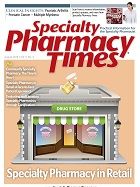Publication
Article
Specialty Pharmacy Times
Specialty Is Not Always Pharmacy: Uncovered Secrets
Many specialty products require a limited access approach, and specialty pharmacists need to have knowledge of the distribution and supply chain structure.
Many specialty products require a limited access approach, and specialty pharmacists need to have knowledge of the distribution and supply chain structure.
Rarely a week goes by when I do not get a call from pharmacies inquiring as to why they have restricted access to a particular product. Right or wrong, many specialty products warrant a limited access approach to their supply chain, but the drivers are not always obvious.
In constructing the specialty product supply chain, typically every touch point has a cost associated with it. While a manufacturer optimally might want open access (more is better), the reality is open access generally comes with significantly greater costs.
I often hear, “Why can’t my wholesaler or distributor just carry the product?” As pharmacies grew in scale by volume, the growth of independent buying groups and group purchasing organizations, chains buying chains, and other dynamics meant that those pharmacies gained leverage with their distributors resulting in having access to products often lower in cost than they could purchase directly from the manufacturer.
Note that recently all of the large retail chains have entered into agreements with drug wholesalers to supply nearly all of their pharmaceutical products, despite having millions of dollars invested in their own warehouse and supply chain structure. If you own a retail pharmacy, when was the last time you bought a product directly from the manufacturer? Decades ago? And why should you, when the best deal is offered by your distributor?
The distributors offer an excellent service to pharmacy, which few pharmacies realize is subsidized by the manufacturer’s fees paid to distributors. Scale means leverage, and with manufacturers, the larger their portfolio typically the lower the fees they pay to distributors to have their products stocked and shipped to all pharmacies.
You order a product the night before and it shows up the next day. For new or specialty pharmaceuticals, this is not the case regardless of the health care need, price, or circumstances. The distributor fees typically are generally the same percent of the wholesale acquisition cost, even if the product is a low-cost generic (pennies in fees) or a specialty product costing thousands of dollars (hundreds in fees). Despite the distribution activities being identical, moving a widget is moving a widget.
This is not a forum to discuss specific distributor fees; however, the disparity between large and small manufacturers for like or fewer services is astounding. Our “regulators” were asleep at the wheel when they allowed these agreements to go unreviewed as they are one source of cost increases in the marketplace. In pharmaceutical distribution, the pricing a pharmacy receives from its wholesaler fits the slogan “No one gets something for nothing” well. If your supply agreement with your distributor is at a price less than direct, have you asked “How can they do that?”
Yes, distribution is a low-margin business—the difference between distribution and your pharmacy, however, is basis points on billions versus millions, and means millions to the wholesalers’ bottom line. They need your volume to drive purchases to generate cash flow. If you don’t believe me, check out an annual report. I would venture to say one cause of limited distribution is that the fees charged reached a level where that restricted distribution was a viable alternative, so there are consequences.
The new innovative therapies generally come from start-up or novel pharmaceutical companies that have chosen to stay independent versus being purchased by big pharma. When these innovators approach the market, they explore all of the supply chain options, which often include selling their products through distributors (and drug wholesalers). This is where they more often than not hit a financial wall as distributors mandate that in order to access their customers (your pharmacy); the manufacturer must pay a fee-for-service or distribution services agreement for the product to be carried. Don’t pay, and there is no access to your pharmacy.
Typically, these double-digit fees place the new or small innovative manufacturer in a position where they must seek alternative methods of distribution. Traditional pharmaceutical products to retail and hospital settings rarely have an option other than “pay the fees” to distributors for having little done for their product other than “kick the box” across the warehouse to the truck to the pharmacy. One cause of higher pricing is the middleman/distributor.
Some pharma organizations, however, are looking at direct-to-patient options, cutting out retailers in part to avoid these exorbitant fees and add value and convenience to the patient and their products. Likewise, specialty products have more options, as their products can often be sustained through limited distribution and opening up direct accounts with a restricted network of pharmacies. Can your pharmacy play in this space? That is the question you should be asking yourself.
Specialty pharmacy is on fire, and most pharmacies are running into the fire rather than away from it. Nowhere is traditional pharmacy more at risk than in the growth of specialty products. Having survived multiple attacks to their bottom line with the increase of deeply discounted generics and continued negative margin impact from payers of all kinds, the survivors are thriving.
It is not like we did not see it coming. Back in 1998, I co-authored “How-to Guide to Specialty Pharmacy for Retail Independents” and later in 2006, with National Association of Chain Drug Stores (NACDS), issued a while paper entitled “Community Specialty Pharmacy, The Time Is Now and How.” (I’ll be glad to send a copy to anyone who sends me an email.) The point is, specialty pharmacy really is not so new. The trends have been out there for a couple of decades.
Retailers that are not in the mix still can get into the mix. Yes, while the payer-owned specialty pharmacies dominate the space, there is still room for high-quality, locally delivered specialty pharmacy services with or without a central-fill solution. In this edition of Specialty Pharmacy Times, which is being distributed at the NACDS Total Store Expo, we focus on the specialty pharmacy in retail discussion—something which will be part of the specialty story and our coverage for the near and far future as well. Email me and I’ll be happy to send you references to help you get started in this thriving market! Hope we see you in Boston at the NACDS Total Store Expo! SPT
Specialty Pharmacy Times
is THE journal fully committed to setting the publication standard through peer-written and reviewed articles focused on the “real world” of specialty pharmacy practice. We invite you to enjoy this issue and pass it on! We welcome your feedback on this topic and on any topics you would like us to cover in future editions of
Specialty Pharmacy Times
. Please reach out to me at [email protected]. And we also encourage you and your colleagues to subscribe to this unique journal, receive the e-Newsletter, and sign up for the free App by logging on to www.specialtypharmacytimes.com.
About the Author
Dan Steiber, RPh, is a principal of D2 Pharma Consulting LLC (d2rx.com) and is responsible for commercial operations, trade-supply chain strategy development including 3PL selection, regulatory oversight, and “operationalizing” organizations. Dan has served in several senior positions in pharmacy, distribution, and industry over the course of his 35-year career. He is a licensed pharmacist in Texas, Washington, California, and Pennsylvania and is affiliated with several professional associations and publications and a frequent speaker on behalf of many professional organizations. Dan graduated from Washington State University College of Pharmacy and has participated in a variety of postgraduate programs in law and business development/marketing at Harvard University and Northwestern University. Dan currently resides in Highland Village, Texas.







